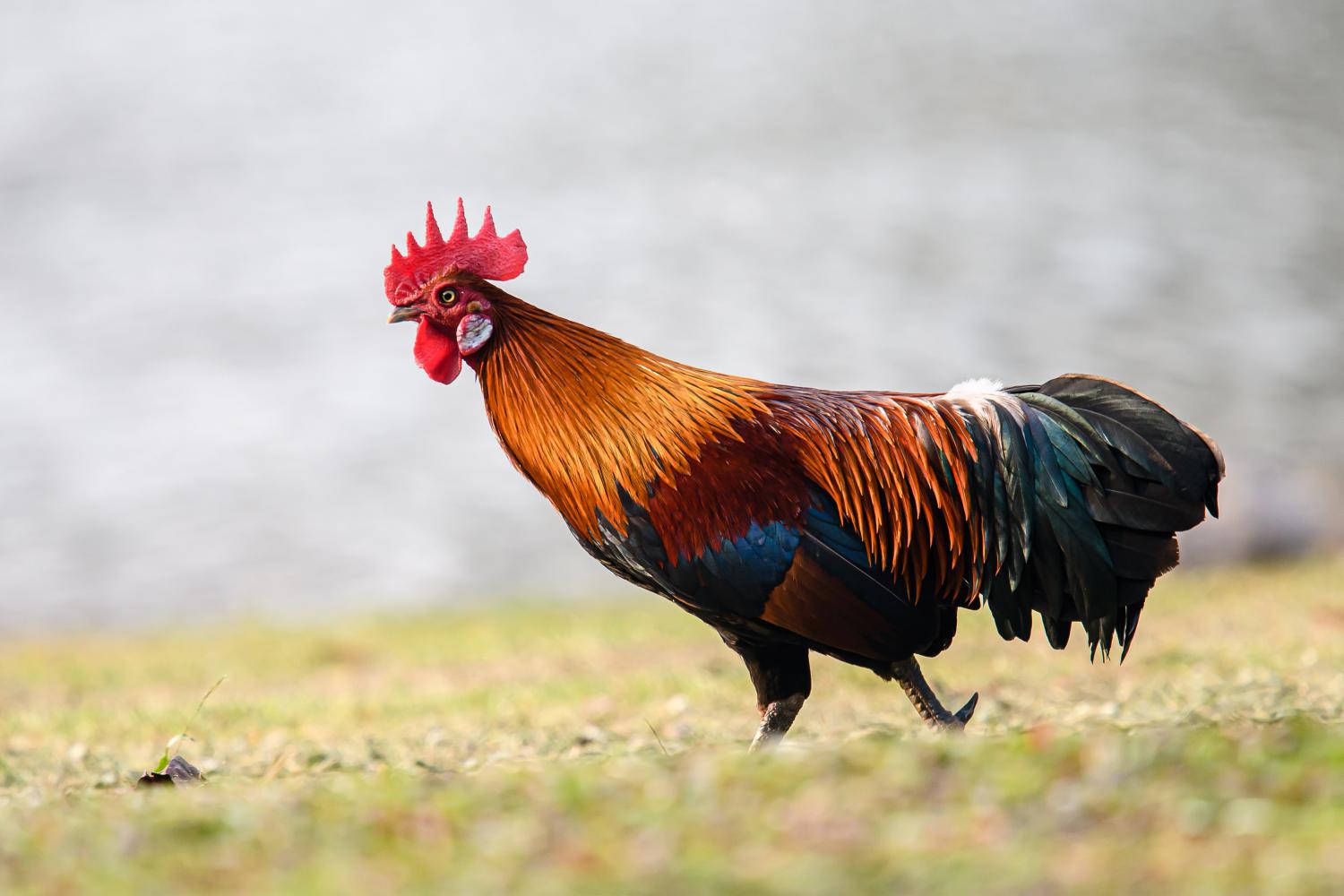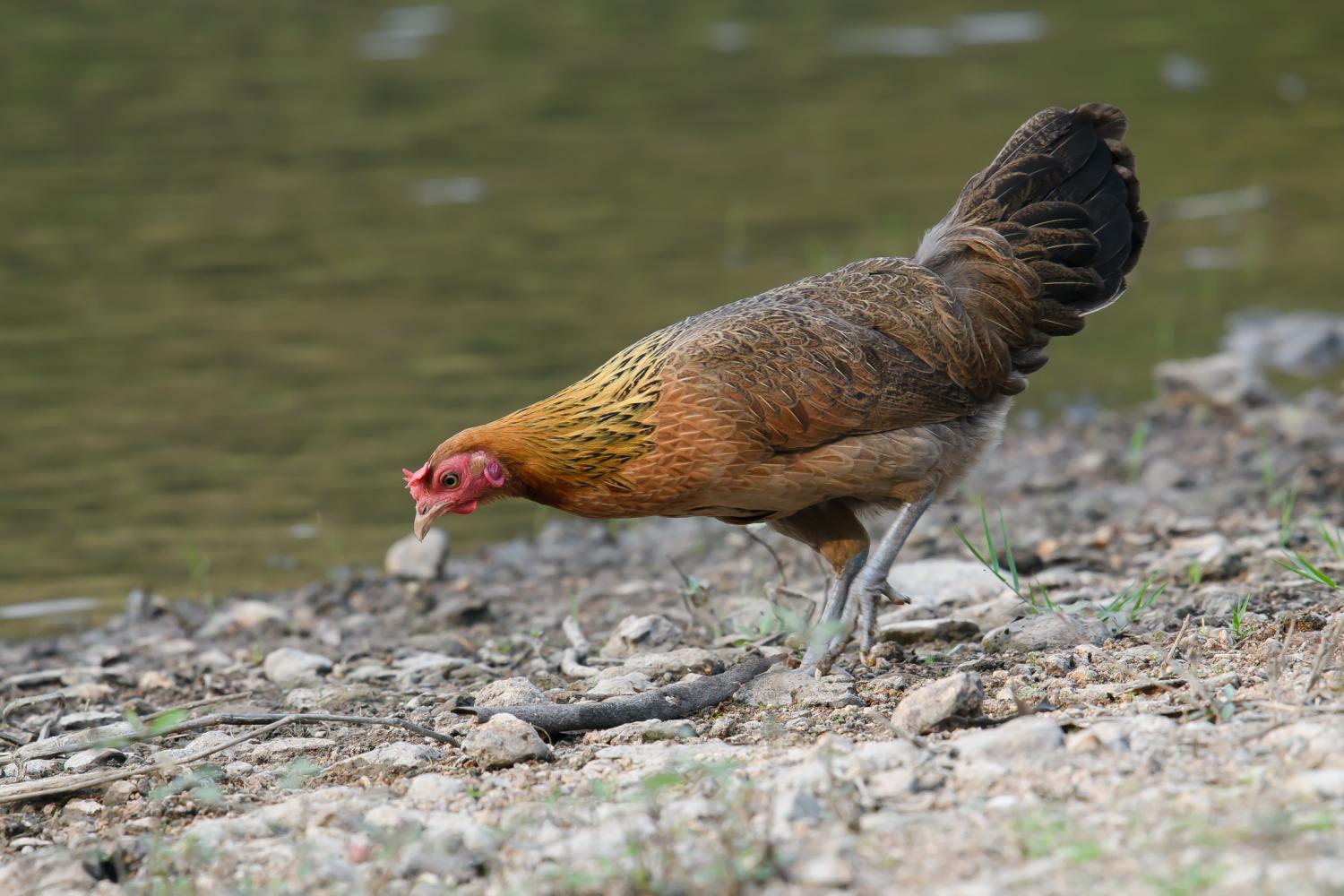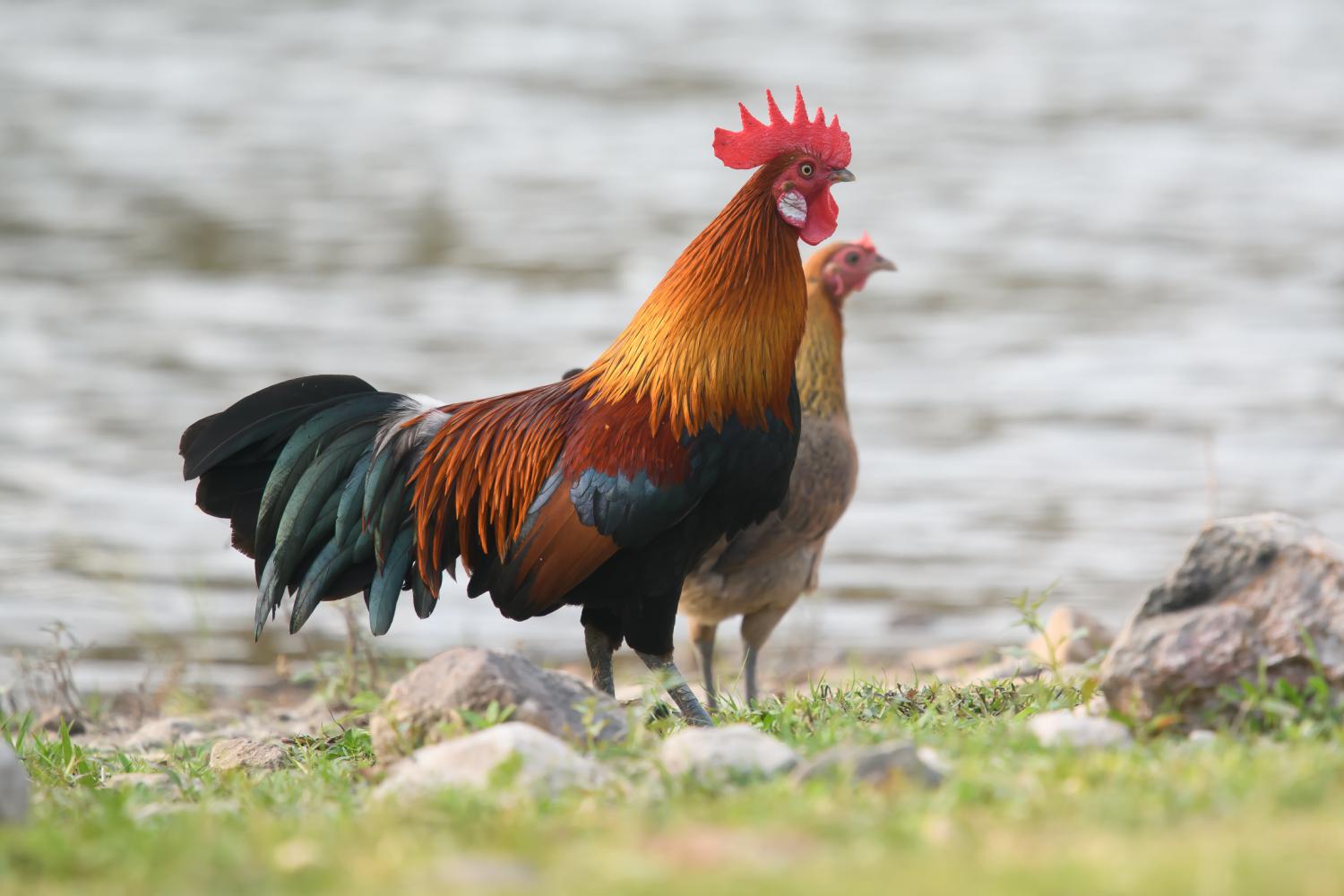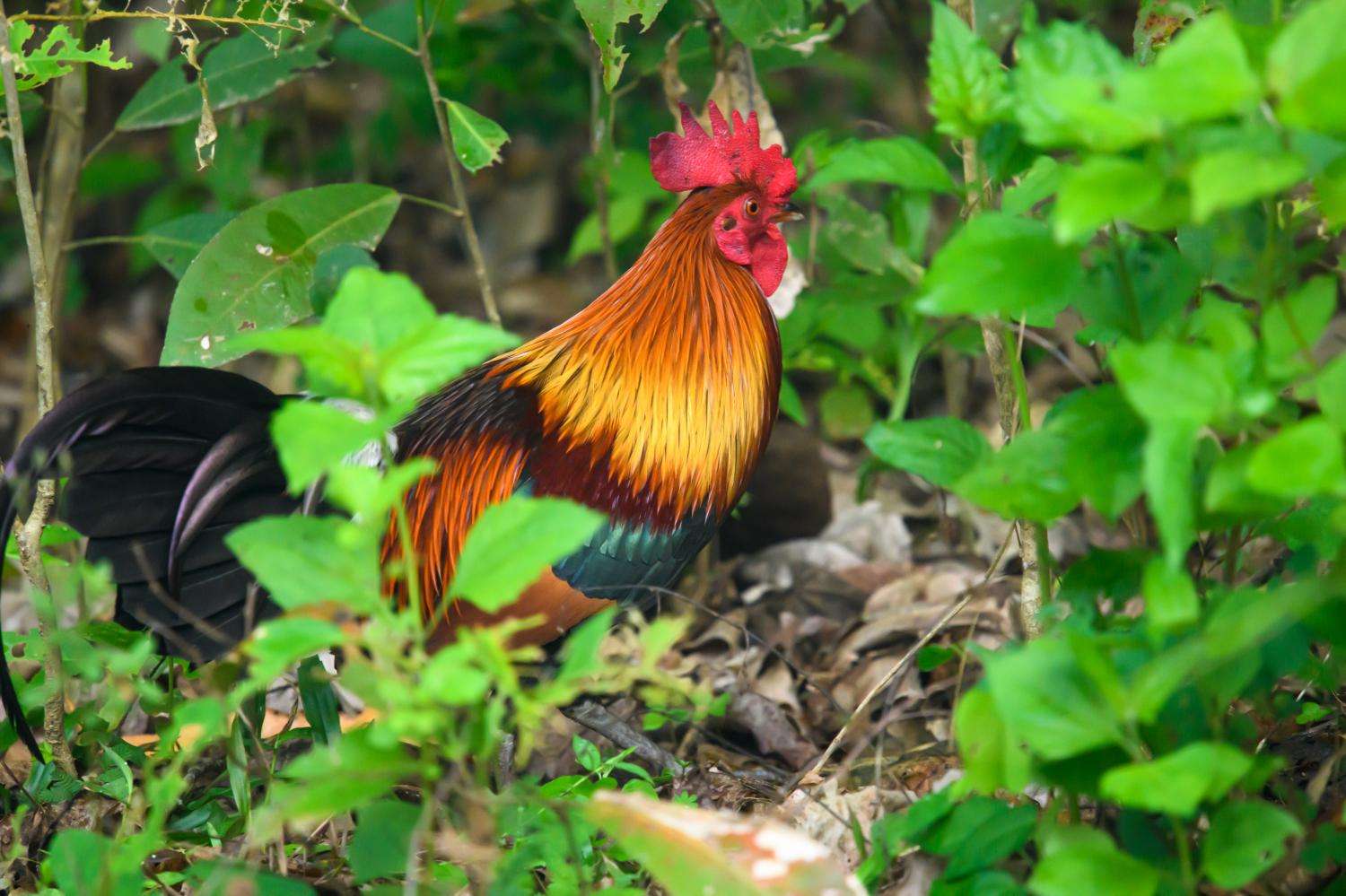Species of Thailand
Red junglefowl
Gallus gallus
Carolus Linnaeus, 1758
In Thai: ไก่ป่า
The red junglefowl (Gallus gallus) is a tropical bird in the family Phasianidae. It ranges across much of Southeast Asia and parts of South Asia. Red junglefowl are the primary ancestor of the domestic chicken (Gallus gallus domesticus); the grey junglefowl, Sri Lankan junglefowl and green junglefowl have also contributed genetic materials to the gene pool of the chicken.
Evidence from the molecular level derived from whole-genome sequencing revealed that the chicken was domesticated from red junglefowl about 8, 000 years ago, with this domestication event involving multiple maternal origins. Since then, their domestic form has spread around the world where it is kept by humans for its meat and eggs.
Taxonomy and systematics
Numerous wild and domestic subspecies of Gallus gallus exist, including:
- G. g. gallus – from Southeast Asia
- G. g. bankiva – from Java
- G. g. jabouillei – from Vietnam
- G. g. murghi – from India and Bangladesh
- G. g. spadiceus – from Myanmar
- G. g. philippensis - from Philippines
- G. g. domesticus – domestic chicken
Description
The nominate race of red junglefowl has a mix of feather colours, with orange, brown, red, gold, grey, white, olive and even metallic green plumage. The tail of the male roosters can grow up to 28 cm, and the whole bird may be as long as 70 cm. There are 14 tail feathers. A moult in June changes the bird's plumage to an eclipse pattern, which lasts through October. The male eclipse pattern includes a black feather in the middle of the back and small red-orange plumes spread across the body. Female eclipse plumage is generally indistinguishable from the plumage at other seasons, but the moulting schedule is the same as that of males.
Compared to the more familiar domestic chicken, the red junglefowl has a much smaller body mass (around 2¼ lbs (1 kg) in females and 3¼ lbs (1.5kg) in males) and is brighter in coloration. Junglefowl are also behaviourally different from domestic chickens, being naturally very shy of humans compared to the much tamer domesticated subspecies.
Sexual dimorphism
Male junglefowl are significantly larger than females and have brightly coloured decorative feathers. The male's tail is composed of long, arching feathers that initially look black, but shimmer with blue, purple, and green in direct light. He also has long, golden hackle feathers on his neck and on his back. The female's plumage is typical of this family of birds in being cryptic and adapted for camouflage. She alone looks after the eggs and chicks. She also has a very small comb and wattles (fleshy ornaments on the head that signal good health to rivals and potential mates) compared to the males.
During their mating season, the male birds announce their presence with the well known "cock-a-doodle-doo" call or crowing. Within flocks, only dominant males crow. Male red junglefowl have a shorter crowing sound than domestic roosters; the call cuts off abruptly at the end. This serves both to attract potential mates and to make other male birds in the area aware of the risk of fighting a breeding competitor. A spur on the lower leg just behind and above the foot serves in such fighting. Their call structure is complex and they have distinctive alarm calls for aerial and ground predators to which others react appropriately.
Distribution and habitat
The range of the wild form stretches from India eastwards across Indochina and southern China, into Malaysia, Singapore, the Philippines, and Indonesia. Junglefowl were one of three main animals (along with the domesticated pigs and dogs) carried by early Austronesian peoples from Island Southeast Asia in their voyages to the islands of Oceania in prehistory, starting at around 5, 000 BP. Today their ancient descendants are found throughout Micronesia, Melanesia, and Polynesia.
Red junglefowl prefer disturbed habitats and edges, both natural and human-created. Apparently the forage and thick cover in these sorts of areas are attractive to junglefowl, especially nesting females. Junglefowl use logged and regenerating forests and often are found near human settlement and areas regenerating from slash-and-burn cultivation. Areas burned to promote bamboo growth also attract junglefowl because bamboo seeds are more available. In some areas, red junglefowl are absent from silvicultural and rubber plantations, but elsewhere they occur in both tea and palm-oil plantations. In Selangor Province, Malaysia, palm foliage provides suitable cover, and palm oil fruit provides adequate food. The palms also offer an array of roost sites, from the low perches (~4 m) favored by females with chicks to the higher perches (up to 12 m) used by other adults.
Red junglefowl drink surface water when it is available, but they apparently do not require it. Birds in North Central India visit water holes frequently during the dry season, although not all junglefowl in the region live close enough to water to do so. Population densities may be lower, however, where surface water is limited.
Behaviour and ecology
Red junglefowl regularly bathe in dust to keep the right balance of oil in their plumage. The dust absorbs extra oil and subsequently falls off.
Flight in these birds is almost purely confined to reaching their roosting areas at sunset in trees or any other high and relatively safe places free from ground predators, and for escape from immediate danger through the day.
Dominant male junglefowl appear to defend a territory against other dominant males, and the size of the territories has been inferred based on the proximity of roosts. Beebe concluded that territories were rather small, especially as compared to some of the pheasants with which he was familiar. This was supported by Collias and Collias, who reported that adjacent roost sites can be as close as 100 meters. Within flocks, male red junglefowl exhibit dominance hierarchies and dominant males tend to have larger combs than subordinate males. Red junglefowl typically live in flocks of one to a few males and several females. Males are more likely to occur alone than are females.
Breeding
Males make a food-related display called "tidbitting", performed upon finding food in the presence of a female. The display is composed of coaxing, cluck-like calls, and eye-catching bobbing and twitching motions of the head and neck. During the performance, the male repeatedly picks up and drops the food item with his beak. The display usually ends when the hen takes the food item either from the ground or directly from the male's beak. Mating then sometimes occurs.
In many areas, red junglefowl breed during the dry portion of the year, typically winter or spring. This is true in parts of India, Nepal, Thailand, Vietnam, and Laos. However, year-round breeding by red junglefowl has been documented in palm-oil plantations in Malaysia and also may occur elsewhere. During the laying period, red junglefowl females lay an egg every day. Eggs take 21 days to develop. Chicks fledge in about 4 to 5 weeks, and at 12 weeks old they are chased out of the group by their mother — at which point they start a new group or join an existing one. Sexual maturity is reached at 5 months, with females taking slightly longer than males to reach maturity.
Dominant males attempt to maintain exclusive reproductive access to females, though females chose to mate with subordinate males about 40% of the time in a free-ranging feral flock in San Diego, California.
Diet
Red junglefowl are attracted to areas with ripe fruit or seeds, including fruit plantations, fields of domestic grain, and stands of bamboo. Although junglefowl typically eat fallen fruits and seeds on the ground, they occasionally forage in trees by perching on branches and feeding on hanging fruit. Fruits and seeds of scores of plant species have been identified from junglefowl crops, along with leaves, roots, and tubers. In addition, red junglefowl capture a wide variety of arthropods, other invertebrates, and vertebrates such as small lizards. Even mammalian feces may be consumed. Many of these items are taken opportunistically as the birds forage, although some arthropods, such as termites, are taken in large quantities; about 1, 000 individual termites have been found in a single crop. Plant materials constitute a higher proportion of the diet of adult red junglefowl than do arthropods and other animals. In contrast, chicks eat mostly adult and larval insects, earthworms, and only occasional plant material.
Relationship to humans
The red junglefowl was domesticated for human use around 8, 000 years ago as subspecies Gallus gallus domesticus. Known as chickens, they are a major source of food for humans. However, undomesticated red junglefowls still represent an important source of meat and eggs in their endemic range. The undomesticated form is sometimes used in cock-fighting.
Timeline of domestication
In 2012, a study examined mitochondrial DNA recovered from ancient bones from Europe, Thailand, the Pacific, and Chile, and from Spanish colonial sites in Florida and the Dominican Republic, in directly dated samples originating in Europe at 1, 000 BP and in the Pacific at 3, 000 BP. Chicken was primarily domesticated from red junglefowl, with subsequent genetic contributions from grey junglefowl, Sri Lankan junglefowl, and green junglefowl. Domestication occurred about 8, 000 years ago, as based on molecular evidence from a common ancestor flock in the bird's natural range, and then proceeded in waves both east and west. Other archaeology evidence suggest domestication date around 7, 400 BP from the Chishan site, in the Hebei province of China. However, domestication event in China has now been disputed by several studies citing unfavourable weather condition at the time. In the Ganges region of India, red junglefowl were being used by humans as early as 7, 000 years ago. No domestic chicken remains older than 4, 000 years have been identified in the Indus Valley, and the antiquity of chickens recovered from excavations at Mohenjodaro is still debated.
Hybridisation
The other three members of the genus — Sri Lanka junglefowl (G. lafayetii), grey junglefowl (G. sonneratii), and the green junglefowl (G. varius) — do not usually produce fertile hybrids with the red junglefowl. However, supporting the hypothesis of a hybrid origin, research published in 2008 found that the gene responsible for the yellow skin of the domestic chicken most likely originated from the closely related grey junglefowl and not from the red junglefowl. Similarly, a 2020 study that analysed the whole genomes of Sri Lanka junglefowl, grey junglefowl, and the green junglefowl found strong introgressive hybridisation events in different populations of indigenous village chickens. The study also shows that 71–79% of red junglefowl DNA is shared with the domestic chicken. A culturally significant hybrid between the red junglefowl and the green junglefowl in Indonesia is known as the bekisar.
Status
Wild-type red junglefowl are thought to be facing threats due to hybridisation at forest edges, where domesticated free-ranging chickens are common. Nevertheless, they are classified by the IUCN as a species of least concern.
This article uses material from Wikipedia released under the Creative Commons Attribution-Share-Alike Licence 3.0. Eventual photos shown in this page may or may not be from Wikipedia, please see the license details for photos in photo by-lines.
Category / Seasonal Status
BCST Category: Recorded in an apparently wild state within the last 50 years
BCST Seasonal status: Resident or presumed resident
Scientific classification
- Kingdom
- Animalia
- Phylum
- Chordata
- Class
- Aves
- Order
- Galliformes
- Family
- Phasianidae
- Genus
- Gallus
- Species
- Gallus gallus
Common names
- Thai: ไก่ป่า
Subspecies
Gallus gallus bankiva, Coenraad Jacob Temminck, 1813
Range: Java
Gallus gallus domesticus, Carolus Linnaeus, 1758
Range: (domestic chicken)
Gallus gallus gallus, Carolus Linnaeus, 1758
Range: Indochina
Gallus gallus jabouillei, Jean Théodore Delacour & Norman Boyd Kinnear, 1928
Range: Vietnam
Gallus gallus murghi, Herbert Christopher Robinson & Cecil Boden Kloss, 1920
Range: India
Gallus gallus spadiceus, Pierre Joseph Bonnaterre, 1792
Range: Burma
Conservation status

Least Concern (IUCN3.1)
Photos
Please help us review the bird photos if wrong ones are used. We can be reached via our contact us page.
Range Map

- Ban Lat District, Phetchaburi
- Bang Pa In District, Phra Nakhon Si Ayutthaya
- Bang Phra Non-Hunting Area
- Bueng Khong Long Non-Hunting Area
- Chae Son National Park
- Chaloem Rattanakosin National Park
- Chiang Dao District, Chiang Mai
- Chiang Dao Wildlife Sanctuary
- Chiang Khong District, Chiang Rai
- Chiang Saen District, Chiang Rai
- Doi Chong National Park
- Doi Inthanon National Park
- Doi Lang
- Doi Pha Hom Pok National Park
- Doi Phu Kha National Park
- Doi Suthep - Pui National Park
- Erawan National Park
- Hala-Bala Wildlife Sanctuary
- Hat Chao Mai National Park
- Hat Yai District, Songkhla
- Huai Kha Khaeng Wildlife Sanctuary
- Huai Nam Dang National Park
- Huai Yang Waterfall National Park
- Kaeng Khoi District, Saraburi
- Kaeng Krachan National Park
- Kaeng Krung National Park
- Khao Ang Rue Nai Wildlife Sanctuary
- Khao Chamao - Khao Wong National Park
- Khao Dinsor (Chumphon Raptor Center)
- Khao Luang National Park
- Khao Nan National Park
- Khao Nang Phanthurat Forest Park
- Khao Phanom Bencha National Park
- Khao Phra - Bang Khram Wildlife Sanctuary
- Khao Phra Thaeo Wildlife Sanctuary
- Khao Sam Roi Yot National Park
- Khao Sanam Prieng Wildlife Sanctuary
- Khao Soi Dao Wildlife Sanctuary
- Khao Sok National Park
- Khao Yai National Park
- Khlong Phanom National Park
- Khon San District, Chaiyaphum
- Khun Chae National Park
- Khun Phawo National Park
- Khun Tan District, Chiang Rai
- Ko Chang District, Trat
- Kui Buri National Park
- Lam Nam Nan National Park
- Lan Sang National Park
- Mae Fa Luang District, Chiang Rai
- Mae Moei National Park
- Mae Ping National Park
- Mae Rim District, Chiang Mai
- Mae Wong National Park
- Mueang Chiang Mai District, Chiang Mai
- Mueang Chiang Rai District, Chiang Rai
- Mueang Krabi District, Krabi
- Mueang Nakhon Nayok District, Nakhon Nayok
- Mueang Phuket District, Phuket
- Mueang Surat Thani District, Surat Thani
- Mueang Tak District, Tak
- Mueang Uttaradit District, Uttaradit
- Nam Nao National Park
- Nam Phong National Park
- Namtok Sam Lan National Park
- Nong Bong Khai Non-Hunting Area
- Nong Ya Plong District, Phetchaburi
- Pang Sida National Park
- Pang Sila Thong District, Kamphaeng Phet
- Pha Daeng National Park
- Phan District, Chiang Rai
- Phatthana Nikhom District, Lopburi
- Phi Phi Islands
- Phra Nakhon Si Ayutthaya District, Phra Nakhon Si Ayutthaya
- Phu Chong Na Yoi National Park
- Phu Foi Lom National Park
- Phu Hin Rong Kla National Park
- Phu Khiao Wildlife Sanctuary
- Phu Langka National Park
- Phu Luang Wildlife Sanctuary
- Phu Suan Sai National Park
- Phu Toei National Park
- Phu Wiang National Park
- Phu Wua Wildlife Sanctuary
- Pran Buri Forest Park
- Ramkhamhaeng National Park
- Sadeth Naikrom - Krom Luang Wildlife Sanctuary
- Sai Yok District, Kanchanaburi
- Sai Yok National Park
- Sakaerat Environmental Research Station
- Salawin National Park
- Samae San Island
- San Kala Khiri National Park
- Sirinat National Park
- Sri Nakarin Dam National Park
- Sri Phang-nga National Park
- Sukhirin District, Narathiwat
- Ta Phraya National Park
- Taksin Maharat National Park
- Tat Mok National Park
- Tat Ton National Park
- Tha Sala District, Nakhon Si Thammarat
- Tha Yang District, Phetchaburi
- Thale Ban National Park
- Tham Chao Ram Wildlife Sanctuary
- Thap Lan National Park
- Thung Salaeng Luang National Park
- Thung Yai Naresuan Wildlife Sanctuary
- Umphang Wildlife Sanctuary
- Wiang Kaen District, Chiang Rai
- Wiang Lo Wildlife Sanctuary





